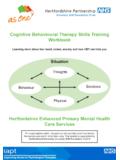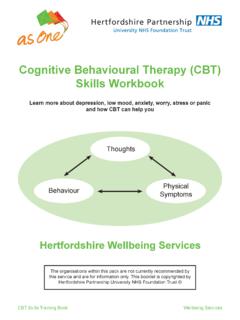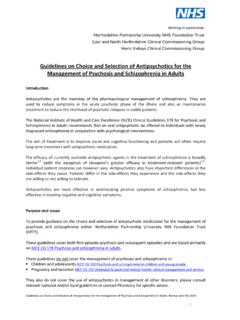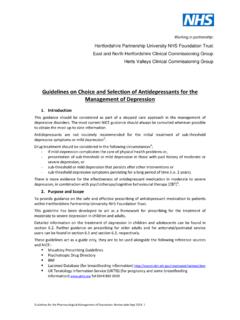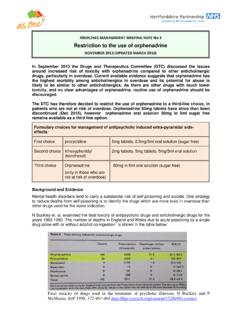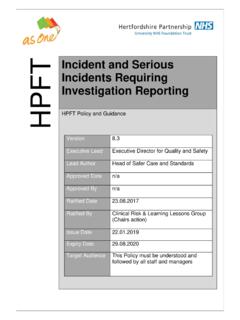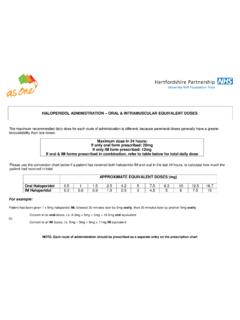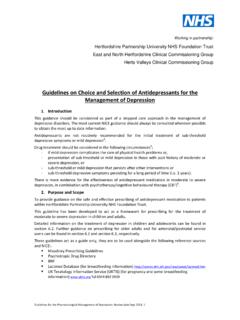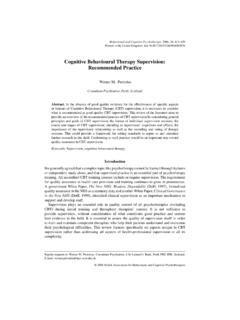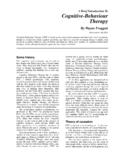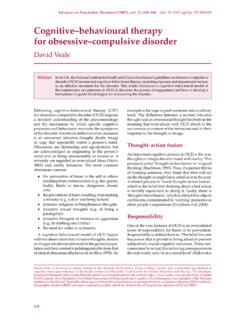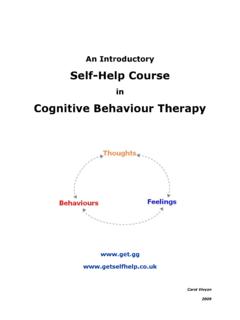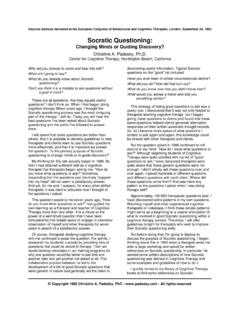Transcription of Cognitive Behavioural Therapy Skills Training Workbook
1 CBT WorkbookIAPTC ognitive Behavioural Therapy Skills Training WorkbookLearning more about low mood, stress, anxiety and how CBT can help youHertfordshire Enhanced Primary Mental Health Care ServicesThe organisations within this pack are not currently recommended by this service and are for information only. This booklet is copyrighted by Hertfordshire Partnership University NHS Foundation Trust Situation Thoughts PhysicalBehaviour Emotions2 Hertfordshire Partnership University NHS Foundation TrustCBT WorkbookIAPTC ontentsIntroductionWhat is Anxiety and Low Mood?A Cognitive Behavioural Therapy Based ApproachSetting GoalsTool 1 - Increasing Activity LevelsTool 2 - Facing Your FearsTool 3 - Thought ChallengingTool 4 - Problem SolvingTool 5 - Getting a Good Night s SleepCreate Your Own Wellbeing BlueprintNext StepsFurther Reading- 3- 4- 7- 11- 16- 22- 28- 42- 46- 48- 51- 523 Hertfordshire Partnership University NHS Foundation TrustCBT WorkbookIAPTI ntroductionStress, low mood and anxiety can affect many people at different times in their lives.
2 Sometimes life can be very difficult. We might feel low due to bereavement or anxious and stressed due to having money problems, or having to attend a job interview. Although we often cannot change the life experiences we go through, we can change how we react to these experiences and we can learn how to manage our Enhanced Primary Mental Health Service (EPMHS) provides support for people who are experiencing difficulties with depression or anxiety. This Workbook has been designed to be used either as self-help, or in conjunction with attending one of our one day CBT Skills Training Workshops. The aim of this Workbook is to introduce you to a number of tools that will help you build up your own tool bag which will give you some Skills to manage your mood.
3 The tools covered in this Workbook are based on the principles of Cognitive Behavioural Therapy , which will be explained later on in the will notice as you read through the Workbook that there are a number of exercises for you to complete which will help you learn the CBT tools. Try and work through the exercises and perhaps spend more time on those that seem more useful to you and your problems and remember that as with any Skills , the tools may need some time to learn and practice! 4 Hertfordshire Partnership University NHS Foundation TrustCBT WorkbookIAPTWhat is Anxiety and Depression?What is Anxiety?Anxiety is an emotion which usually involves an element of worry and fear.
4 It is a state of mind but can also affect our thoughts, behaviours and physical reactions in our body. Although anxiety can be unpleasant, it is actually an evolutionary survival mechanism. When we find ourselves in dangerous or stressful situations, anxiety helps us by preparing our body to either run away or fight back. This is known as the fight versus flight anxiety can help us survive, it can start to become a problem when we use the fight versus flight response when there is no need. Anxiety is natural and helpful in dangerous or stressful situations but becomes a problem when we experience anxiety when we are not in a dangerous or stressful situation or long after a dangerous or stressful situation has is Anxiety?
5 5 Hertfordshire Partnership University NHS Foundation TrustCBT WorkbookIAPTWhat is Low Mood?Low mood is another emotion which can cause emotional distress. People can often experience a number of different symptoms that can affect the way that we think, the things that we do, as well as the physical symptoms that we can experience. This can then impact people further by causing their mood to deteriorate even more. Research has shown that the main causes for low mood can be linked to genetics, biology, early experiences in life, a combination of stressful events or even major life events such as a relationship breakdown, loss of a loved one or any traumatic feeling low, people may find themselves thinking negatively about themselves and thinking that other people do not like them.
6 A common symptom of low mood is that people tend to withdraw from activities or social interaction, as well as having difficulties staying or trying to sleep, as well as eating. People experiencing low mood can also think that life is not worth living, or may even think about harming or killing themselves. This can be quite common for people who are experiencing these difficulties. Having thoughts like these can be quite scary but does not mean that you will act on them. It is important to speak to your GP, the mental health helpline on 01438 843322 or attend the nearest Accident and Emergency department if you feel concerned about acting on any thoughts about harming yourself or anyone else.
7 This will ensure that you get the correct help and support that is needed. What is Low Mood?6 Hertfordshire Partnership University NHS Foundation TrustCBT WorkbookIAPTA ctivityTake a look at the lists below for some common symptoms of anxiety and low mood. Feel free to tick the symptoms which you experience:ThoughtsEmotions "Something awful is going to happen" Anxious "I will not be able to cope" Scared "What if I don t do it right" Nervous "What will people think of me" Irritable "I need to escape" DepressedPhysical SymptomsBehaviours Faster heart beat Avoiding situations Physical tension Increased smoking or drinking Dizziness Arguing Hot and sweaty Talking or doing things faster Tunnel vision Under or over eatingHow does anxiety affect you?
8 ThoughtsEmotions "I m a failure" Depressed "People think I m stupid" Sad "Nobody likes me" Lethargic "There s no point, I won t enjoy it" Irritable "I might as well not be here" SuicidalPhysical SymptomsBehaviours Difficulties sleeping Social withdrawal Poor appetite or over eating Increased smoking or drinking Tearful Decrease in activities Loss of sex drive Sleeping during the dayHow does low mood affect you?7 Hertfordshire Partnership University NHS Foundation TrustCBT WorkbookIAPTA Cognitive Behavioural Therapy Based ApproachWhat is CBT? Cognitive Behavioural Therapy (CBT) is a talking Therapy which can help people look at the different situations that they find themselves in, and to understand their thoughts, emotions and behaviours.
9 The idea is that our thoughts, emotions, physical symptoms and behaviour can all influence one another and therefore help to maintain unhelpful moods such as low mood. Take a look at the diagram Thoughts PhysicalBehaviour EmotionsThe CBT model emphasises that it is not the situation that causes the emotional distress that an individual experiences. CBT argues that it is the individual s interpretation or view of that event or situation which causes the emotional distress. CBT works by focussing on the negative thoughts and learning how to challenge them, as well as learning how to change unhelpful behaviours such as Partnership University NHS Foundation TrustCBT WorkbookIAPTWhen feeling low or anxious, it is common to have negative automatic thoughts or nats.
10 These are unhelpful thoughts that pop into our minds without any effort. With anxiety, nats are often about overestimating threat and underestimating an individual s ability to cope, which can maintain any anxiety. Sometimes people find coping mechanisms which help them deal with the situation. This may involve avoiding the situation, or doing something differently in order to help control their anxiety. Although this may lower their anxiety in the short term, it can actually maintain and reinforce it in the long term. Breaking this vicious cycle may cause an increase in anxiety to begin with but ultimately help reduce it. The example below is of Linda. Her situation is chairing a meeting at work.
